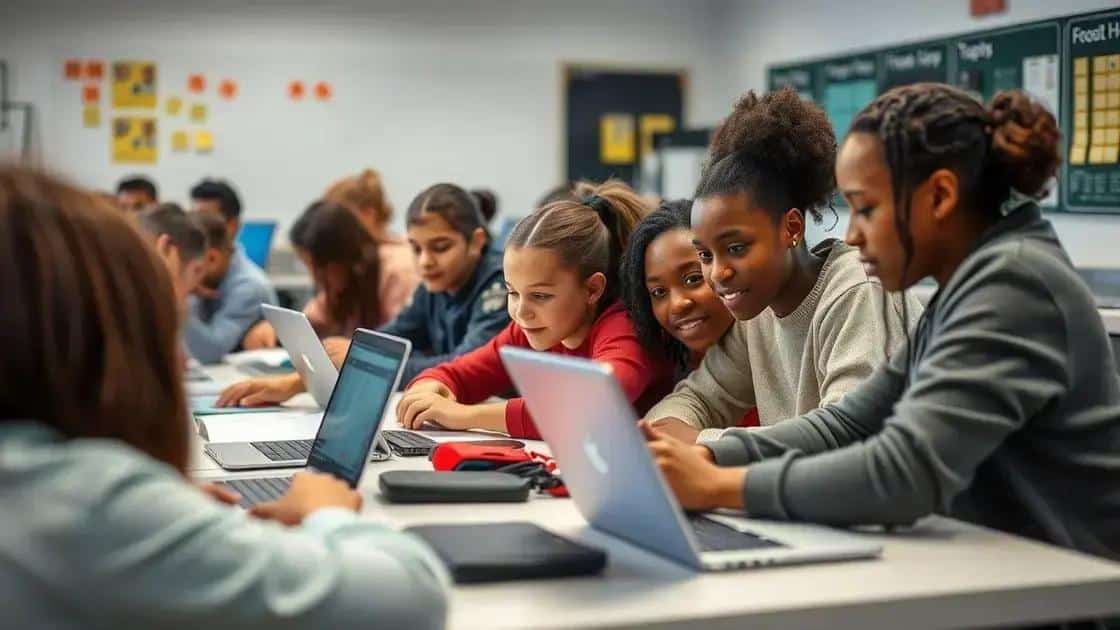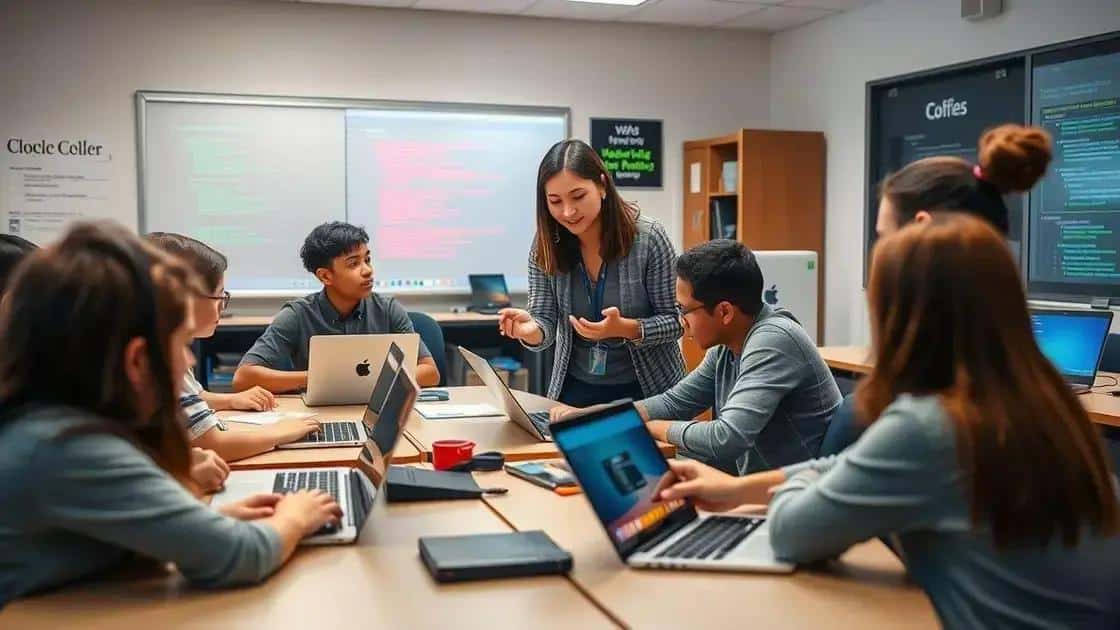Insights on high school coding classes that inspire students

High school coding classes provide essential skills for students, fostering problem-solving abilities and creativity while preparing them for diverse career opportunities in today’s technology-driven job market.
Insights on high school coding classes reveal the transformative power of technology education in preparing students for future careers. Have you wondered how coding skills shape young minds? Let’s explore the impact together.
Importance of coding skills in today’s job market
In today’s rapidly evolving world, the importance of coding skills in the job market cannot be overstated. As technology continues to advance, many industries are seeking professionals who possess these valuable skills. Understanding how coding fits into various career paths can help students see the relevance of their lessons.
Why Coding Matters
Coding is like learning a new language; it allows individuals to communicate with computers and create applications that can solve real problems. In several fields, ranging from marketing to healthcare, coding skills enable professionals to innovate and improve processes. Companies increasingly value employees who can adapt to changing technologies.
Career Opportunities
Having coding skills opens up numerous career opportunities. Here are a few fields where coding is particularly beneficial:
- Software Development: Building apps, websites, and software.
- Data Analysis: Using code to analyze data and gather insights.
- Cybersecurity: Protecting systems and networks from threats.
- Game Development: Creating engaging video games and simulations.
Moreover, even jobs that do not primarily focus on coding often prefer candidates with some coding knowledge. Being familiar with programming languages can set applicants apart from their peers.
Enhancing Problem-Solving Skills
Learning to code also enhances critical thinking and problem-solving abilities. It encourages students to approach challenges systematically and to break them down into manageable parts. This mindset is crucial in every career, helping individuals become effective leaders and innovators.
As the job market evolves, it is clear that coding will remain a vital skill. By incorporating coding into high school curriculum, educators can equip students with the tools they need to succeed in their futures.
Engaging teaching methods for coding classes

Engaging teaching methods for coding classes can significantly enhance the learning experience for students. By making lessons interactive and relatable, teachers can help students connect with the material more deeply. One effective way to achieve this is through hands-on projects that encourage creativity and collaboration.
Interactive Learning Experiences
Using gamification in the classroom can transform coding lessons into enjoyable challenges. Students can participate in coding games or competitions where they can see their progress in real time. This approach not only motivates students but also fosters a spirit of teamwork.
Project-Based Learning
Through project-based learning, teachers can assign meaningful tasks that require students to apply coding concepts. Here are some projects that can engage students:
- Developing a simple website showcasing their interests.
- Creating an interactive game that their classmates can play.
- Building a digital story using coding techniques.
- Participating in community coding events or hackathons.
These projects encourage students to think critically and develop problem-solving skills while working on something they are passionate about.
In addition, encouraging peer collaboration can enhance the learning process. When students work together, they can share ideas and tackle challenges from different perspectives. This collaborative environment promotes a deeper understanding of coding concepts and builds communication skills.
Incorporating Technology Tools
Utilizing online platforms and coding tools can also make lessons more dynamic. There are many resources available that allow students to practice coding interactively. For example, coding tutorials and online challenges can guide students at their own pace. This flexibility is particularly helpful for diverse learning styles.
Additionally, providing immediate feedback is crucial. Utilizing platforms that offer real-time code feedback can help students identify mistakes and learn from them promptly. This instant recognition improves the learning curve and boosts students’ confidence.
Real-world applications of coding in high school
Understanding the real-world applications of coding in high school is essential for students. By connecting classroom lessons to practical uses, educators can boost student engagement. Coding is not just a skill for tech professionals; it applies to various fields and daily life, making it a vital subject.
Coding in Everyday Life
Coding influences many areas in our daily routines. From social media platforms to mobile applications, coding helps us interact with technology. Even non-tech careers like marketing and finance increasingly utilize coding to analyze data or automate repetitive tasks. Recognizing this connection helps students see the value of their coding skills.
Enhancing Career Readiness
Many employers look for candidates with coding skills. Here are a few industries where coding is particularly valuable:
- Healthcare: Developing applications to manage patient data and improve care.
- Finance: Using programs for data analysis and decision-making.
- Education: Creating interactive learning tools and educational software.
- Entertainment: Producing video games and multimedia content.
These examples show how coding can make students more competitive in the job market. Knowing how to code prepares them for future challenges.
Problem-Solving and Innovation
Learning to code also fosters problem-solving skills. Students create solutions to complex challenges by working on coding projects. This process encourages analytical thinking and innovation, skills that are valuable in any career. For instance, a student might design a program to help other students track their homework. This not only reinforces coding skills but also develops their ability to solve real-world problems.
Furthermore, coding allows students to bring their ideas to life. Whether they want to build a website for a club or create a mobile app, coding provides the tools to turn their visions into reality. This empowerment can lead to exciting projects and career paths.
Tips for creating a successful coding curriculum

Creating a successful coding curriculum involves a strategic approach that meets students’ needs while preparing them for real-world applications. When designing this curriculum, it is essential to focus on engagement, relevance, and clear learning outcomes.
Understand Your Audience
Before developing the curriculum, it’s important to understand your students. Are they beginners or have they had some experience with coding? Knowing their skill level helps tailor the curriculum to ensure it is challenging yet achievable. Additionally, incorporating their interests can increase motivation.
Set Clear Goals
Establishing clear objectives is crucial for a successful coding curriculum. Consider including:
- Fundamental coding concepts such as loops and functions.
- Hands-on projects that encourage creativity and problem-solving.
- The ability to apply coding skills in team settings.
- Assessment methods to track progress and provide feedback.
These goals guide both instructors and students, making the learning path clearer and more focused.
Incorporate Diverse Resources
Using a variety of teaching resources can help keep the classes interesting. This might include online tutorials, coding apps, and interactive platforms that allow for real-time feedback. These tools can accommodate different learning styles and encourage independent study among students.
Regularly introducing new resources also keeps students engaged. Changing up the learning materials can make lessons more dynamic, allowing students to explore topics more deeply.
Encourage Collaboration and Teamwork
Building a collaborative environment fosters communication and teamwork. Students can work on group projects, sharing ideas and solving problems together. This not only enhances their coding skills but also prepares them for future teamwork in the workplace. Projects can range from app development to creating a game, allowing students to express their creativity.
Moreover, inviting guest speakers from the tech industry can provide valuable insights and inspire students. Exposure to real-world experiences can make the curriculum feel more relevant and exciting.
FAQ – Frequently Asked Questions about High School Coding Classes
Why is coding education important for high school students?
Coding education equips students with skills that are essential in today’s digital world, preparing them for future careers and promoting problem-solving abilities.
What are some engaging methods for teaching coding in high school?
Interactive projects, gamification, and collaborative team activities are effective methods to make coding lessons more engaging and impactful.
How can coding skills be applied in real-world situations?
Coding skills are applicable in various fields, including healthcare, finance, and technology, enabling students to create applications and solve real problems.
What tips are there for creating a successful coding curriculum?
Focus on understanding student needs, set clear goals, incorporate diverse resources, and encourage collaboration to create an effective coding curriculum.





